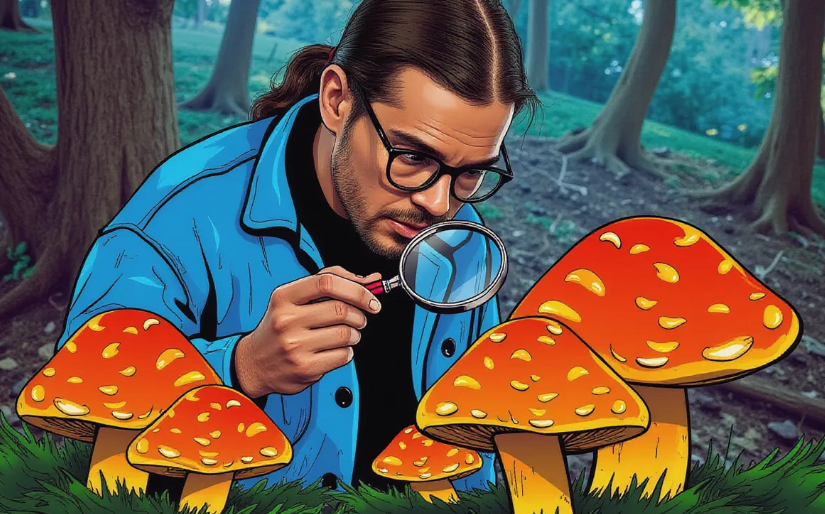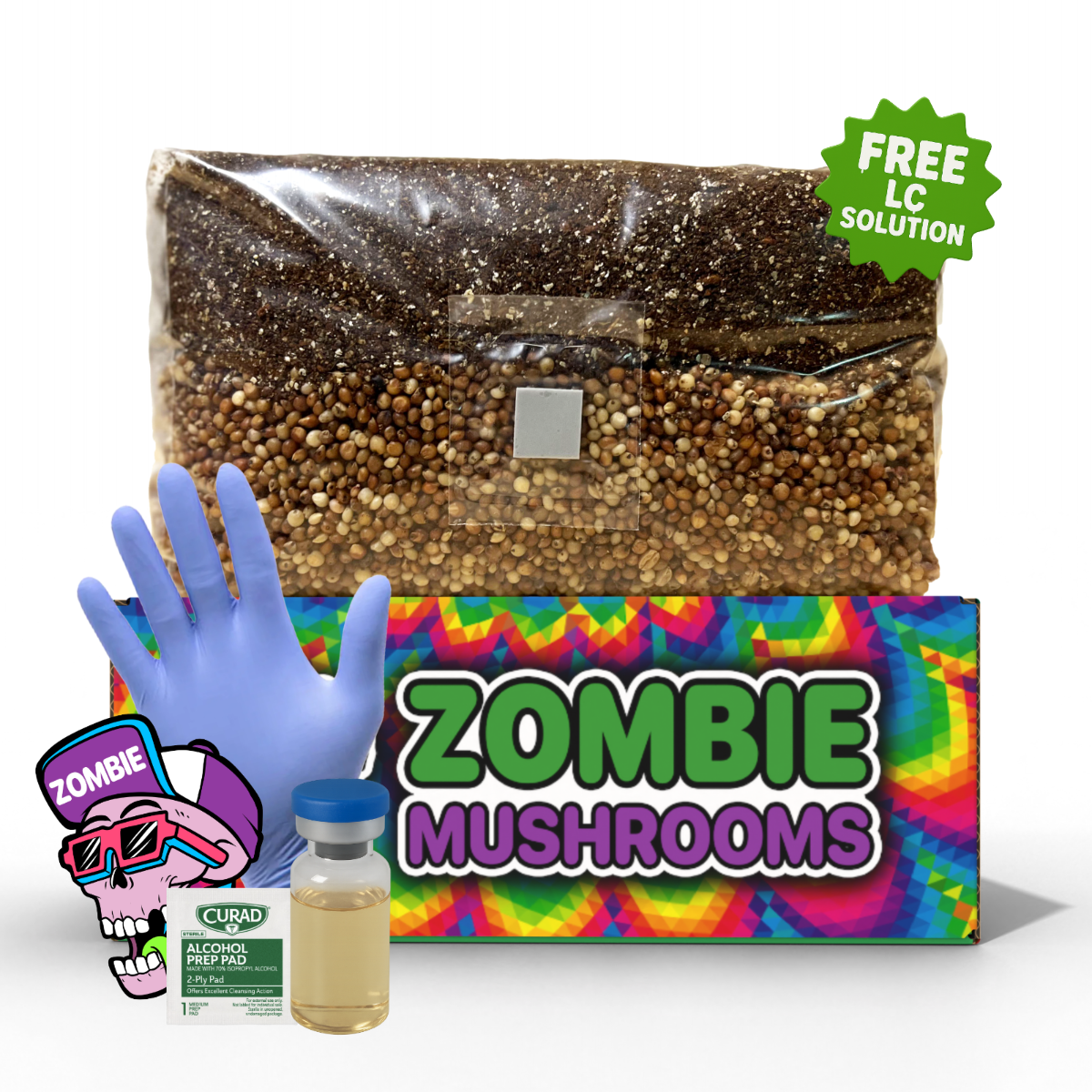⬇️ Prefer to listen instead? ⬇️
- PSK from Turkey Tail has shown efficacy in enhancing immune responses in cancer patients.
- Turkey Tail contains PSP and PSK, potent polysaccharides that support immune modulation.
- False Turkey Tail lacks the white pores that define true Trametes versicolor.
- Turkey Tail can be easily cultivated at home using grow kits, avoiding misidentification risks.
- Antioxidants in Turkey Tail combat oxidative stress, promoting better cellular health.
If you’re new to mushroom foraging or checking out medicinal fungi, Turkey Tail mushrooms are a good place to begin. Loved in holistic health circles and more and more backed by science, this colorful, shelf-like fungi helps immune function and has good antioxidant benefits. There are lookalikes in nature, so proper mushroom ID is key—not only for safety but also to be sure you’re getting the real benefits of Turkey Tail.

What Is a Turkey Tail Mushroom?
Turkey Tail (Trametes versicolor), often found growing on dead or decaying hardwoods, is a polypore mushroom with interesting visual and therapeutic traits. Known for its bright, color zones in rings that look like a wild turkey’s tail feathers, this mushroom has been respected in traditional Chinese medicine for a long time and is now becoming popular in Western wellness. It grows well in forests around the world, making thick groups on fallen branches, logs, and stumps. It plays a big part in wood breaking down and forest health.
From an ecological view, Turkey Tail mushrooms are saprophytic—meaning they eat dead organic stuff. This helps recycle nutrients and also makes them easy to find if you know the dead hardwood places to look for.
Besides its ecological role, Turkey Tail is widely used for its medicinal uses. It's often in mushroom supplements and blends for its immune-boosting parts, and researchers are very interested in its polysaccharides—mainly PSK (Polysaccharide-K or Krestin) and PSP (Polysaccharide-Peptide)—for different health uses.

What Does a Real Turkey Tail Look Like?
To ID mushrooms right, you must know the key physical signs of the species. Turkey Tail mushrooms are among the most bright and patterned fungi, with colors that can be many shades of brown, rust, orange, tan, blue, gray, and white—all in clear rings on the top.
Key ID features of real Turkey Tail mushrooms (Trametes versicolor)
- Fan-Shaped Caps: They are usually semi-circular or fan-like brackets that are about 2 cm to more than 7 cm across.
- Clustered Growth: They grow in thick groups or rosettes on dead hardwood logs and tree stumps.
- Velvety or Hairy Surface: If you look closely, the cap feels soft or fuzzy because of tiny hairs. This is more clear when it's fresh.
- Concentric Color Bands: Many color zones always go around the edges, often going back and forth between darker and lighter colors. These bright bands give the mushroom its name.
- Underside with Tiny White Pores: The bottom of the cap has a pore surface that is white to off-white. These pores are packed close and are how the mushroom releases spores.
- Thin and Flexible Texture: The caps are leathery but a bit bendy when fresh and get brittle when dried.
This complex but steady mix of features is what makes real Turkey Tail different from lookalikes.

False Turkey Tail and Other Lookalikes
One of the most important things to do to eat or gather Turkey Tail safely is to tell it apart from its many lookalikes. False Turkey Tail (Stereum ostrea) and some other Trametes types often confuse new foragers—and even experienced ones sometimes.
Stereum ostrea (False Turkey Tail)
Stereum ostrea is the most common imposter. It looks like Turkey Tail's wavy cap shape and banded color but doesn't have the pore underside.
Key Differences
- Pore Surface: It has no pores at all—its underside is smooth and can be dull yellow to orange.
- Texture: It's usually thinner, tougher, and more “papery” than Trametes versicolor.
- Hairiness: The top is usually smooth or only a little hairy.
- Medicinal Use: False Turkey Tail doesn't have the same medicinal traits and should not be eaten.
| Feature | Turkey Tail (Trametes versicolor) | False Turkey Tail (Stereum ostrea) |
|---|---|---|
| Pores | Yes, white and tightly packed | No, smooth yellow-orange underside |
| Upper Texture | Velvety, hairy | Leathery and thin |
| Color | Multicolored concentric rings | Also banded but less bright contrast |
| Edibility | Medicinal; widely studied | Not medicinal; unknown edibility |
Other Confusing Species
- Trametes hirsuta: It's in the same group and often grows in similar places. It has a hairy cap and pores underneath but doesn't have the bright color of Trametes versicolor.
- Trametes ochracea: It has shelf-like shapes but is thicker and has more steady ochre-brown color. It doesn't have the bright bands of real Turkey Tail.
- Lenzites betulina: It's sometimes mistaken for Turkey Tail because of cap color and texture but has gills instead of pores underneath—a key difference.

Turkey Tail Identification Checklist
When you are outside, having a checklist helps make sure you ID mushrooms right. Use this quick guide to check if you’ve found a real Turkey Tail:
- Grows on fallen hardwood logs or tree stumps
Circular, multicolored bands (blue, gray, brown, orange, etc.)
Upper cap feels fuzzy or velvety
White to off-white tiny pores packed close on the underside
Thin, a bit bendy cap (fresh), brittle when dried
Usually grows in layers or rosettes that overlap
Expert tip: Take a 10x magnifying lens when foraging. Looking at pore shapes close up can help you be more sure you have the right ID.

Best Practices for Safe Mushroom Foraging
To forage mushrooms well, never guess. Even though Turkey Tail is seen as one of the safer mushrooms to ID because of its unique parts, having safe habits will help you avoid risky mistakes—mainly as you learn more types of foraging.
Here are key best habits
- Use Field Guides: Good regional mushroom field guides have photos, ID tips, and toxic lookalikes.
- Join Local Foraging Groups: Learning with experienced mushroom experts or foragers gives great hands-on learning.
- Take Spore Prints: Turkey Tail spore prints are white. To do this, put a cap on dark paper overnight. The spore pattern can help check the ID.
- Photograph and Compare: Carry photos you took before—or use mushroom ID apps that let you upload a picture for AI to check.
- If Unsure, Don’t Eat It: The main rule of foraging. Even if you think you know, don't eat wild mushrooms if you are not totally sure.
- Learn Seasonal Patterns: Turkey Tail grows all year in many places but is brightest in wet months like spring and fall. Learn the calendar signs in your area.

Turkey Tail Benefits for Wellness
More interest in Turkey Tail mushroom supplements comes not only from traditional medicine but also from more science showing Turkey Tail benefits.
Immune Support & Modulation
Turkey Tail has two important active parts—PSP (Polysaccharide Peptide) and PSK—that help balance and boost the immune system.
-
PSK, also called Krestin, has been approved in Japan since the 1980s as extra cancer help. Studies suggest it helps improve survival in patients getting chemo, mainly for stomach and colon cancers [(Fujii, Itoh, & Tazaki, 1978)].
-
PSP, found in China, has similar immune effects and may help support general immune strength.
Antioxidant Power
Turkey Tail has many antioxidants, including phenols and flavonoids. These parts fight free radicals, which add to swelling, aging, and many long-term illnesses [(Kozarski et al., 2015)].
Gut and Digestive Health
Turkey Tail is a prebiotic, so it may help feed good gut bacteria, improving digestion and maybe helping nutrient absorption. A healthy microbiome is seen more and more as key for body-wide wellness.
Potential in Cancer Therapy
Research on Turkey Tail’s cancer-fighting traits keeps showing good results. When used with normal treatments like chemo or radiation, Turkey Tail supplements may help lessen side effects, improve energy, and maybe make people live longer [(Wasser, 2014)].

How to Consume Turkey Tail Mushrooms
Turkey Tail is fibrous, so you can't eat it like button or cremini mushrooms. Instead, you usually take extracts or brew it as tea.
Popular Ways to Consume
- Teas: Simmer dried Turkey Tail pieces for at least 30–60 minutes to get out polysaccharides. Add herbs like ginger or turmeric for flavor and more benefits.
- Tinctures: Liquid extracts using alcohol (or dual extraction methods with alcohol and hot water) for best part availability.
- Capsules & Powders: Easy and good for travel. Look for products with fruiting body extract, not filler mycelium grown on grain.
- Supplement Blends: Often in immune-boosting products, sleep aids, and nootropic stacks.
Are There Any Risks or Side Effects?
Turkey Tail is usually seen as safe, mainly when grown and IDed right. But, like all supplements and foraged food
- Allergies: People sensitive to mushrooms or molds should be careful.
- Autoimmune Conditions: Because Turkey Tail changes the immune system, ask a doctor if you have autoimmune or swelling problems.
- Drug Interactions: Mainly when used with immune drugs or cancer treatments, Turkey Tail could change how medicines work.

Can You Grow Turkey Tail at Home?
Yes—and it might be the best way to begin. Growing Turkey Tail at home gives a year-round, sure source of this medicinal mushroom. It takes away guessing from foraging and is a very educational hands-on thing to do.
Benefits of home growing
- Safety: You know you have the right species if you get it from good sellers like Zombie Mushrooms.
- Access: Fresh or dried mushrooms when you need them.
- Sustainability: Less impact on wild groups.
- Education: Learn about the mushroom life and growing ways.
Zombie Mushrooms has easy grow kits, sterilized agar plates, grain spawn, and liquid cultures—all needed to start (and grow) your home mushroom work.

Why Turkey Tail Is Perfect for First-Time Foragers
Foraging can be scary because of toxic fungi. Turkey Tail is a safe and good target for your first outdoor trips because of these things
- Abundance: Found across North America, Europe, and Asia in many forests.
- Distinct Features: Underside pores, rings, velvety texture—all features that are easy to ID.
- Few Dangerous Lookalikes: Most can be ruled out with simple visual signs and field tools.
- Medicinal Value: Gives quick wellness use compared to non-medicinal finds.
IDing and learning about Turkey Tail can be a base for growing your general mushroom knowledge.
Quick Recap: Real vs. Fake Turkey Tail
To sum up how to tell real vs. fake Turkey Tail easily
- Look for pore-patterned, white undersides (NOT smooth undersides).
- Check for multicolor bands on fan-shaped caps.
- Check if the top texture is velvety or hairy, not shiny or papery.
- Use spore prints and field guides if you're unsure.
- Don't take any fungi that look like Turkey Tail with smooth, orangish undersides (Stereum ostrea!).
If you worry about right ID, begin by growing Turkey Tail at home to be safe and get good immune benefits—and learn useful things from your kitchen or backyard lab.
Citations
- Fujii, T., Itoh, H., & Tazaki, H. (1978). Clinical evaluation of PSK (polysaccharide Krestin) immunotherapy in cancer patients. Japanese Journal of Clinical Oncology, 8(1), 43–52.
- Kozarski, M., Klaus, A., Jakovljevic, D., Todorovic, N., Bohanek, B., & Niksic, M. et al. (2015). Antioxidants of edible mushrooms. Molecules, 20(10), 19489–19525. https://doi.org/10.3390/molecules201019489
- Wasser, S. P. (2014). Medicinal mushroom science: History, current status, future trends, and unsolved problems. International Journal of Medicinal Mushrooms, 16(1), 1–16.



